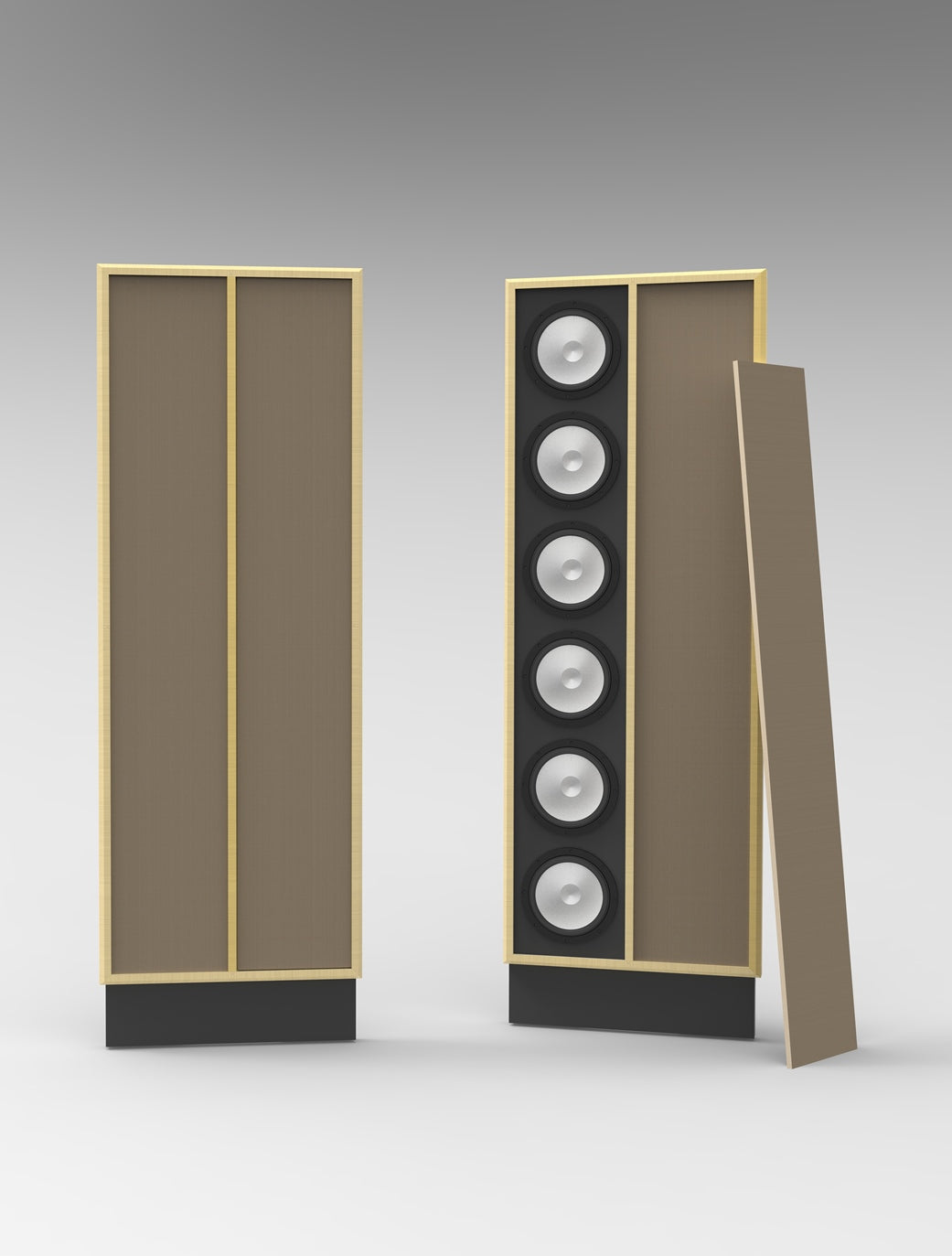Nine.Five
$23,500.00
The brand new JansZen Nine.Five loudspeaker is modeled after Arthur A. Janszen's famed KLH Nine, but modernized with a freshened look and vastly improved performance and practicality. The model name is still somewhat up in the air, but may remain Nine.Five , which is meant honor the KLH Nine while implying that there are five ways that the new model improves on that iconic first ever, truly full range electrostatic speaker.
The original: You may remember the KLH Nine. Developed by Arthur A. Janszen in the mid-1950’s, it sported William H. Barton’s mid-century modern industrial design. It was put into field tests in 1957 by JansZen Laboratory. In 1959, Arthur joined KLH as CTO, bringing his groundbreaking design with him as the KLH flagship, which remains highly respected to this day.
The Nine was the first truly full range electrostatic speaker, in that it made deep bass -- flat to 40 Hz -- reached sufficient volume levels for all sorts of music, and was reliable. These characteristics contrasted with its beloved, erstwhile contemporary, the QUAD ESL 57.
The KLH Nine garnered strong praise over the years, including from J. Gordon Holt, who declared it in 1968 as ". . . the most nearly perfect loudspeaker we have ever heard, and we've heard every likely contender that's in commercial production. It does not favor some instruments over others, but seems to make everything sound almost perfectly natural."
The new: The JansZen Nine.Five builds on that venerable achievement and transforms it into a lasting icon for our century.
Woofing: In the old days, dynamic woofers were already being paired with electrostatic midranges and tweeters, but not seamlessly. Nowadays, there are dynamic woofers that rival electrostatics, so all JansZen electrostatics use dynamic woofers for the bass. Making the transition seamless is still a good trick, of course, and we've mastered it in all our loudspeakers.
Having a 200 Hz crossover, the woofers in the Nine.Five aren't asked to come anywhere near the frequencies where they would deviate from purely pistonic action, so among other advantages, there's no breakup coloration whatsoever. The woofers in the Nine.Five also have properties that allow them to operate well as dipoles, open baffle.
Each speaker system has six 8”, ceramic cone woofers that are exceptionally light, responsive, and linear. They produce absolutely natural and impactful bass that will have you doubting that the sound is being reproduced by speakers. The dipole configuration minimally excites room modes, and the large surface area projects a palpable wavefront with transients like drum beats, low bass string plucks, and hammer-on's.
Dipole operation also unloads the woofers at deep bass frequencies, so bass extension is limited only by dipole cancellation roll-off, not the suspension. This creates a flat response to 40 Hz, with further extension slightly assisted by their well damped, 25 Hz aggregate resonant frequency.
Tweeting: Since the electrostatic panel crosses over to the woofers at only 200 Hz, it handles most of the audio spectrum, namely the upper bass, midrange, and treble. Consequently all the sound that requires the very highest sonic fidelity is reproduced by the electrostatic panel. Since there is thus no chance that either the woofers or the electrostatic panel can possibly experience breakup, and floor bounce is practically eliminated by the tall aperture and wide range floor distances, the sound is smooth as silk from top to bottom.
Stat configuration: The electrostatic panel is 8” wide and 48” tall. It's configured as a synthetic aperture line array, which is truly unique. What this means is that it is divided into narrow vertical segments -- five segments in this case. The central segment gets the straight signal, with sequential time delays to each pair of flanking segments. This makes the entire 8” wide array have dispersion similar to a merely 1.2” wide strip -- ±20° at 10 kHz -- yet it produces much higher SPL than a 1.2" wide strip.
This approach resembles QUAD’s synthetic point source array (ESL-63 and later), but since QUAD’s central area is rather wide, it still beams narrowly, whereas the Nine.Five has wide enough dispersion to allow considerable leeway in seating position without losing the treble.
In contrast to point sources, a line array has the advantage that the loudness doesn’t change much when moving away from each speaker. Thus, when listening from well off to one side of a stereo pair, you can thus easily hear the sound from the farther speaker, so the image doesn’t just collapse onto the near speaker when you move off center, it merely shifts off center along with you.
Another advantage to a line array is that there is practically no effect on tonality when changing listening height, in this case from about 26" to 72” above the floor at a 7' listening distance. A very subtle 1.5° back-tilt increases the maximum listening height, reduces back wall interference effects, and increases standing stability.
An active version of this model is in the works and will be priced at $34,500. It will have four amplifiers in each enclosure, one for the woofers and three for the electrostatic panel. The panel needs three independent signals to accomplish the dispersion widening effect of the synthetic aperture. Each amplifier is capable of delivering 500W into 4Ω. The time delays for the array aperture will be accomplished at line level in analog circuitry. There will also be analog circuitry for adjusting each speaker's bass response to overcome room modes. This comprises two knobs for tamping down one or two room modes, and one for bringing the overall bass response back up to match the individual reductions, or to simply to turn up the bass.
Specifications:
Driver complement: one 8” x 48”, individually hand made, synthetic aperture, electrostatic line array, and six 8” ceramic cone woofers per loudspeaker
Recommended amplifier power rating: 80W – 500W/channel into 8 Ohms
Impedance: 5 Ohms nominal, 4 Ohms minimum
Sensitivity: 82 dB/1W/1m (pink noise)
Maximum SPL: 110 dB in room in stereo at a 2m listening position, with 6 dB headroom available for transients
Size: 6' high x 2' wide x 3" thick
Weight: 90 lb per loudspeaker
Electrostatic panel sensitivity is adjustable downward by up to 6 dB for bass-shy or bright rooms
Construction: Solid hardwood frame (choice of hard maple, cherry, and walnut) with high grade corner joinery, plywood baffles, hard maple base with choice of natural poly finish or post catalyzed paint that’s scratch resistant and impervious to solvents, powder coated steel base plate, open weave linen grill cloth, hard anodized, perforated aluminum rear grill, power coated steel electronics enclosure.
Designed and hand made in the USA.
Price: The projected list price will be $32,500/pair. While dealers are still being recruited, as is currently the case, however, the direct price is as listed above, namely $23,500.
Dealer inquiries encouraged.
Pricing may be determined through this web site, but you'll have to contact us to talk about specifics and for ordering:
- Phone: +1 (614) 448-1811
- WhatsApp: +1 (614) 592-1789
- Skype: janszen_esl1
Or use our CONTACT page to send us a note.

